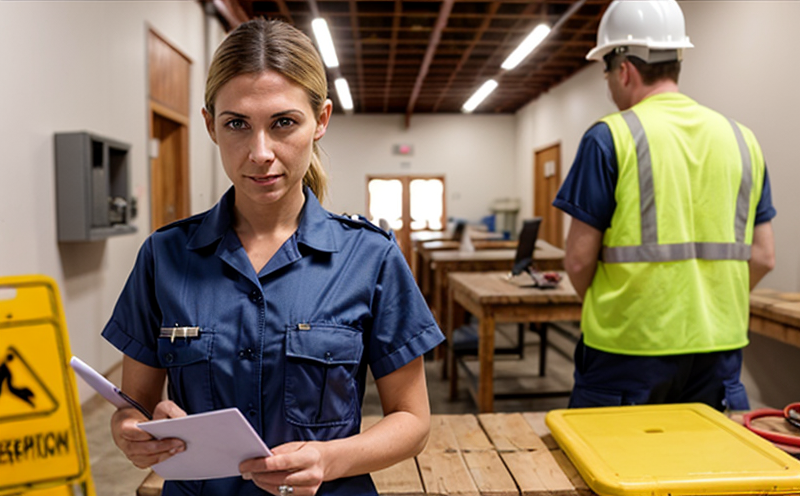Occupational health inspection
The Occupational Health Inspection is a critical component of Environmental Health and Safety (EHS) management. This service ensures that workplaces are safe, healthy, and compliant with all relevant regulations and standards. In the context of EHS, occupational health inspections serve to identify potential risks associated with work environments and activities. These inspections help prevent accidents and illnesses in the workplace by identifying hazards, evaluating control measures, and recommending corrective actions where necessary.
Occupational health inspections are essential for quality managers, compliance officers, R&D engineers, and procurement specialists as they ensure that workplaces meet regulatory requirements and industry best practices. By conducting these inspections, organizations can minimize risks to their employees, improve productivity, and enhance the overall safety culture within the workplace.
The scope of an occupational health inspection includes a thorough assessment of the work environment, including physical conditions such as temperature, humidity, noise levels, lighting, ventilation, and ergonomics. It also involves evaluating the presence and use of hazardous materials, machinery, tools, and equipment that could pose risks to employees.
During these inspections, professionals will review workplace policies and procedures related to health and safety, including emergency response plans, first aid provisions, and fire safety measures. They also assess the training provided to employees on safe working practices and ensure compliance with relevant legislation such as OSHA (Occupational Safety and Health Administration) in the United States or EU regulations.
Once the inspection is complete, a detailed report will be generated outlining all findings. This document serves several purposes: firstly, it provides an overview of any deficiencies found during the inspection; secondly, it offers recommendations for corrective actions to address these issues; and finally, it acts as evidence that due diligence has been exercised towards maintaining a safe working environment.
By implementing regular occupational health inspections, organizations not only fulfill their legal obligations but also demonstrate their commitment to employee well-being. This proactive approach can lead to reduced absenteeism rates, lower insurance premiums, improved staff morale, and enhanced reputation among clients and stakeholders.
In summary, an effective occupational health inspection plays a pivotal role in safeguarding the health and safety of workers while contributing positively towards organizational goals related to sustainability and productivity.
Applied Standards
- ISO 45001: Occupational Health and Safety Management System Requirements - This international standard specifies requirements for an occupational health and safety management system that enables organizations to plan, implement, review, and improve their OHSMS.
- AWS Z840-2016 American National Standard for Respiratory Protection - This document provides guidance on selecting appropriate respirators based on specific workplace hazards such as dust, fumes, gases, or vapors.
The application of these standards ensures that our inspections adhere to recognized best practices and are consistent with global norms. Compliance with such standards enhances the credibility of our services and helps clients achieve their own regulatory objectives.
Quality and Reliability Assurance
- Consistent Reporting: Each inspection is conducted using standardized procedures, ensuring that all findings are consistently documented across different locations or times.
- Peer Reviews: Reports undergo rigorous peer review by experienced professionals to ensure accuracy and completeness before being issued.
The reliability of our occupational health inspections stems from our commitment to maintaining high standards throughout every stage of the process. We employ certified inspectors who possess deep knowledge in occupational health and safety principles. Our robust quality control measures, including continuous training programs for staff and regular audits of internal processes, further reinforce this dedication.
Additionally, we utilize advanced technologies and methodologies that allow us to capture detailed data about each inspection. This information is stored securely using our proprietary software systems, which enable quick retrieval whenever needed. The use of automation also reduces human error while increasing efficiency, leading to more accurate assessments and timely recommendations.
Competitive Advantage and Market Impact
- Enhanced Reputation: By consistently delivering high-quality occupational health inspections, we help our clients build trust with employees and stakeholders. This positive reputation can attract new business opportunities and strengthen existing relationships.
- Potential Cost Savings: Identifying hazards early through regular inspections allows organizations to implement preventive measures before costly accidents or illnesses occur. This proactive approach often results in reduced medical expenses, lower workers' compensation claims, and fewer downtime incidents due to workplace injuries.
Our services provide significant advantages over competitors by offering unparalleled expertise and cutting-edge technology. Clients benefit from our deep understanding of occupational health issues combined with state-of-the-art tools that enable precise evaluations. This combination ensures that inspections are thorough yet efficient, providing valuable insights into potential risks and solutions tailored to each unique workplace environment.
In the competitive market for EHS services, being able to offer reliable, accurate, and timely occupational health inspections sets us apart from other providers. Our clients appreciate not only the technical excellence of our team but also their dedication to ensuring that every inspection contributes towards creating safer, healthier work environments.





